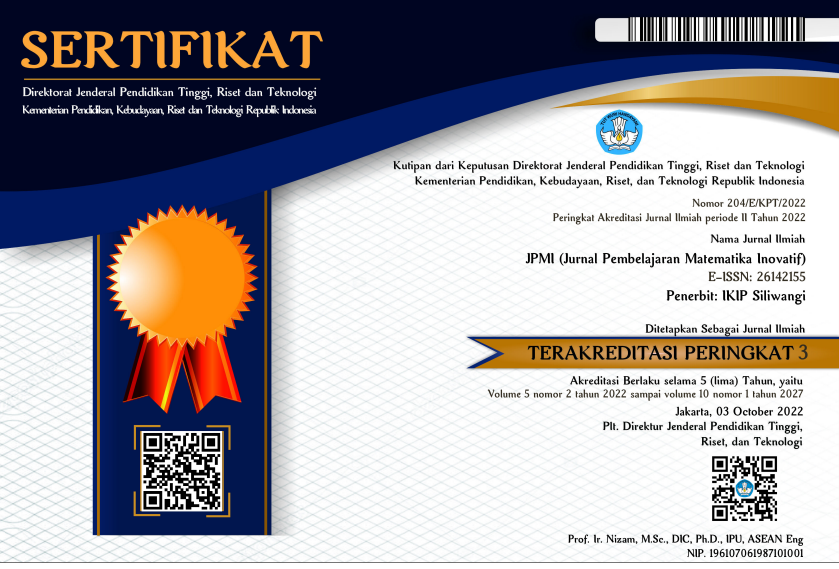ANALISIS EPISTEMOLOGICAL OBSTACLE SISWA SMA PADA MATERI TRIGONOMETRI
DOI:
https://doi.org/10.22460/jpmi.v3i5.p%25pKeywords:
Epistemological Obstacle, TrigonometryAbstract
References
Alfian, T. D., (2014). Penanaman Nilai Wawasan Kebangsaan dan Patriotisme Melalui Pembelajaran Sejarah di SMA Negeri 1 Wonosari Klaten. Skripsi Universitas Negeri Yogyakarta.
Aripin, U. (2015). Meningkatkan Kemampuan Pemahaman Matematik Siswa Smp Melalui Pendekatan Pembelajaran Berbasis Masalah. P2M STKIP Siliwangi, 2(1), 120.
Fitriani, N. (2015). Hubungan Antara Kemampuan Pemecahan Masalah Matematis dengan Self Confidence Siswa SMP yang Menggunakan Pendekatan Pendidikan Matematika Realistik. Jurnal Euclid, 2(2), 341–351.
Kadarisma, G., & Amelia, R. (2018). Epistemological Obstacles in Solving Equation of Straight Line Problems. International Conference on Mathematics and Science Educayion, 3, 905–910.
Khotimah, K., Yuwono, I., Rahardjo, S., Pendidikan, P., Universitas, M., & Malang, N. (2016). Kesulitan Siswa Dalam Menyelesaikan Soal Perbandingan Trigonometri. Prosiding Seminar Nasional Pendidikan Matematika, 1, 46–52.
Prihadi, Y. (2014). Pengembangan Perangkat Pembelajaran Matematika dengan Pendekatan Kontekstual pada Pokok Bahasan Trigonometri untuk SMA Kelas X. Skripsi. Universitas Negeri Yogyakarta.
Rismawati, Y., Nurlitasari, L., Kadarisma, G., & Rohaeti, E. E. (2018). Analisis Karakteristik Learning Obstacle Siswa SMP dalam Menyelesaikan Soal Bangun Datar. Jurnal Pembelajaran Matematika Inovatif, 1(2), 99–106.
Rohimah, S. M. (2017). Analisis Learning Obstacles Pada Materi Persamaan Dan Pertidaksamaan Linear Satu Variabel. Jurnal Penelitian Dan Pembelajaran Matematika, 10(1).
Setiawati, E. (2011). Hambatan Epistemologi (Epistemological Obstacles) Dalam Persamaan Kuadrat Pada Siswa Madrasah Aliyah. “Building the Nation Character through Humanistic Mathematics Education, 787–800.
Suryadi, D., Yulianti, K., & Junaeti, E. (2010). Model Antisipasi dan Situasi Didaktis dalam Pembelajaran Matematika Kombinatorik Berbasis Pendekatan Tidak Langsung. Pendidikan Matematika FPMIPA UPI, 1–10.
Utami, R. W., Endaryono, B. T., & Djuhartono, T. (2018). Kemampuan Peserta Didik dalam Menyelesaikan Soal Cerita Matematika. Ilmiah Kependidikan, 5(3), 187–192.

















